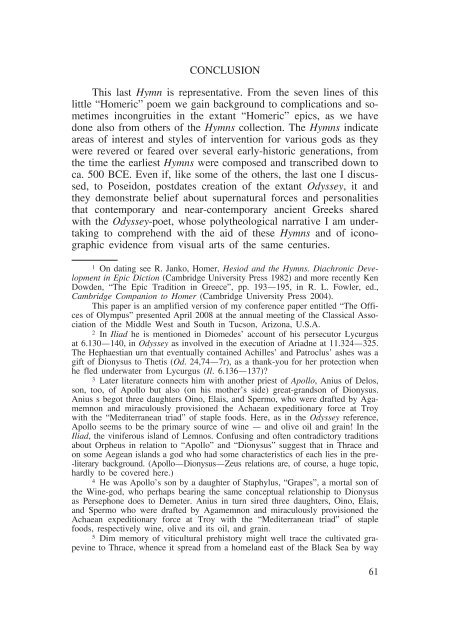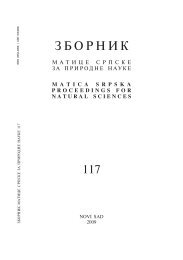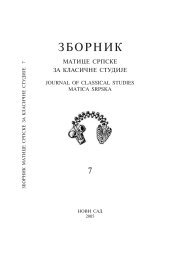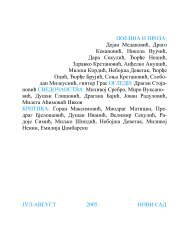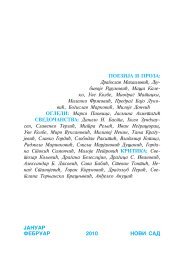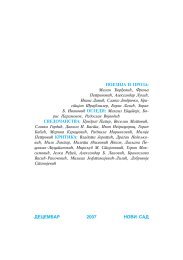You also want an ePaper? Increase the reach of your titles
YUMPU automatically turns print PDFs into web optimized ePapers that Google loves.
CONCLUSION<br />
This last Hymn is representative. From the seven lines of this<br />
little “Homeric" poem we gain background to complications and sometimes<br />
incongruities in the extant “Homeric" epics, as we have<br />
done also from others of the Hymns collection. The Hymns indicate<br />
areas of interest and styles of intervention for various gods as they<br />
were revered or feared over several early-historic generations, from<br />
the time the earliest Hymns were composed and transcribed down to<br />
ca. 500 BCE. Even if, like some of the others, the last one I discussed,<br />
to Poseidon, postdates creation of the extant Odyssey, it and<br />
they demonstrate belief about supernatural forces and personalities<br />
that contemporary and near-contemporary ancient Greeks shared<br />
with the Odyssey-poet, whose polytheological narrative I am undertaking<br />
to comprehend with the aid of these Hymns and of iconographic<br />
evidence from visual arts of the same centuries.<br />
1 On dating see R. Janko, Homer, Hesiod and the Hymns. Diachronic Development<br />
in Epic Diction (Cambridge University Press 1982) and more recently Ken<br />
Dowden, “The Epic Tradition in Greece", pp. 193—195, in R. L. Fowler, ed.,<br />
Cambridge Companion to Homer (Cambridge University Press 2004).<br />
This paper is an amplified version of my conference paper entitled “The Offices<br />
of Olympus" presented April 2008 at the annual meeting of the Classical Association<br />
of the Middle West and South in Tucson, Arizona, U.S.A.<br />
2 In Iliad he is mentioned in Diomedes' account of his persecutor Lycurgus<br />
at 6.130—140, in Odyssey as involved in the execution of Ariadne at 11.324—325.<br />
The Hephaestian urn that eventually contained Achilles' and Patroclus' ashes was a<br />
gift of Dionysus to Thetis (Od. 24,74—7r), as a thank-you for her protection when<br />
he fled underwater from Lycurgus (Il. 6.136—137)?<br />
3 Later literature connects him with another priest of Apollo, Anius of Delos,<br />
son, too, of Apollo but also (on his mother's side) great-grandson of Dionysus.<br />
Anius s begot three daughters Oino, Elais, and Spermo, who were drafted by Agamemnon<br />
and miraculously provisioned the Achaean expeditionary force at Troy<br />
with the “Mediterranean triad" of staple foods. Here, as in the Odyssey reference,<br />
Apollo seems to be the primary source of wine — and olive oil and grain! In the<br />
Iliad, the viniferous island of Lemnos. Confusing and often contradictory traditions<br />
about Orpheus in relation to “Apollo" and “Dionysus" suggest that in Thrace and<br />
on some Aegean islands a god who had some characteristics of each lies in the pre-<br />
-literary background. (Apollo—Dionysus—Zeus relations are, of course, a huge topic,<br />
hardly to be covered here.)<br />
4 He was Apollo's son by a daughter of Staphylus, “Grapes", a mortal son of<br />
the Wine-god, who perhaps bearing the same conceptual relationship to Dionysus<br />
as Persephone does to Demeter. Anius in turn sired three daughters, Oino, Elais,<br />
and Spermo who were drafted by Agamemnon and miraculously provisioned the<br />
Achaean expeditionary force at Troy with the “Mediterranean triad" of staple<br />
foods, respectively wine, olive and its oil, and grain.<br />
5 Dim memory of viticultural prehistory might well trace the cultivated grapevine<br />
to Thrace, whence it spread from a homeland east of the Black Sea by way<br />
61


